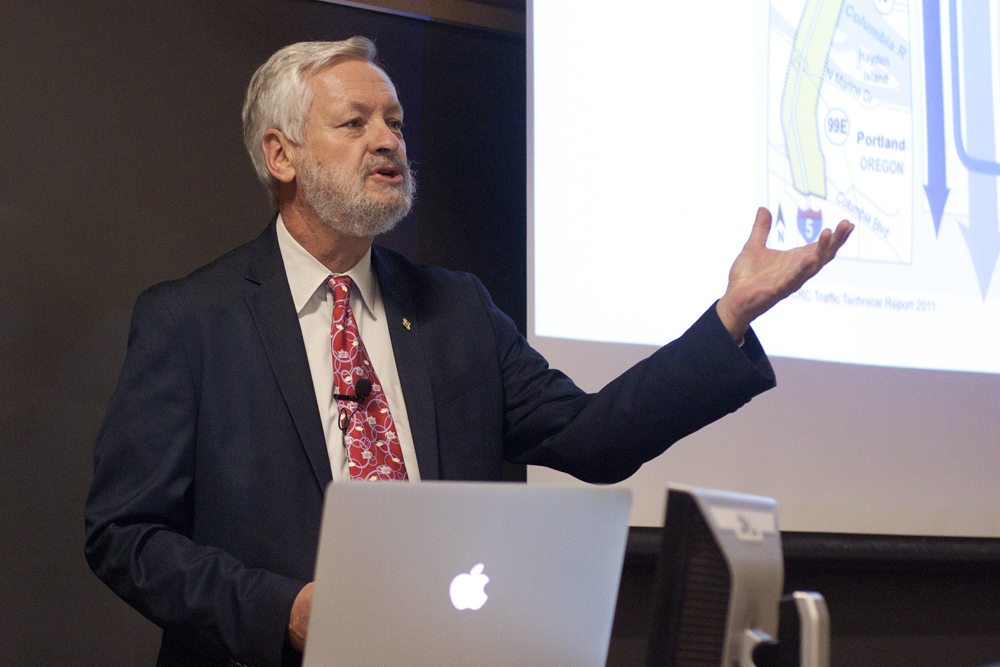Those walking through Portland State’s Parking Structure One may have noticed an addition to the four Toyota RAV 4 electric vehicles: a silver Toyota Prius Hybrid Plug-In (PHV) vehicle.
Hybrid driving for students
Those walking through Portland State’s Parking Structure One may have noticed an addition to the four Toyota RAV 4 electric vehicles: a silver Toyota Prius Hybrid Plug-In (PHV) vehicle.
In partnership with Portland General Electric (PGE) and Toyota, PSU has been given 10 PHVs to evaluate, and should have them until June this year.
PGE Economic Development Director Charlie Allcock said that Toyota has a list of topics about which it is interested in finding out more through this study. Toyota wants to see how certain individuals, in certain situations, use the cars.
Allcock said that from PGE’s perspective, this study will help the company analyze what needs to be done to build an infrastructure for electric vehicles. This includes being able to anticipate and answer customer concerns, such as the effects of charging the car at one’s house.
“From our standpoint, it’s a great example of the benefits of a collaboration of a utility and the local university,” Allcock said. “We’re really happy to be doing this.”
George Beard, alliance manager in the Research and Strategic Partnerships Office and the administrator of the PHV program, said that he assigns the cars to various people throughout the entire state. His goal is to expose the vehicles to as many people and different communities as he possibly can.
Beard wants “not just the political and corporate elite, but real people to have a chance to participate in this.”
“We have [Priuses] in Corvallis, Salem, Eugene and even in Ashland,” Beard said. “I’ve got a car about to be assigned to Willamette University.”
According to Beard, the vehicles are assigned to different people and rotated every couple of months.
David Utzinger, the Portland ZipCar fleet manager, said that ZipCar also received two PHVs on Jan. 27.
One of ZipCar’s PHVs is located in Parking Structure One, while the other is located outside of the Shaver Green Apartments in northeast Portland.
He said that the only way the PHVs differ in use from other cars in the fleet is that they are only allowed to be reserved for hourly use by members. The main reason for this is that the vehicle’s lithium-ion battery takes up so much room, spare tires are not included with each Prius. Without this safety net for drivers, ZipCar doesn’t feel it is safe for members to take the cars on long trips.
According to Beard, while many manufacturers are coming out with electric vehicles and extended-range electric vehicles like the Chevrolet Volt, the Prius uses a different strategy to lower vehicle emissions.
As an example, Beard referred to a large semi-truck. According to Beard, these trucks use a large amount of gas to accelerate from a dead stop. The normal Prius uses its battery to get the car from a dead stop to up to four or five miles per hour; at this point, the vehicle’s combustible engine kicks in. Moreover, the vehicle recaptures electric energy from its wheels and braking system to recharge the battery.
The PHV, however, takes this strategy a step further, Beard said.
“In addition to…this normal Prius advantage, [Toyota said] let’s add a lithium battery to the back of the car that can be charged in a normal 110v [volt] charging socket,” he said.
Beard said that when he takes the car down to Salem, the car seamlessly switches over from the lithium-ion battery to combustible engine when the electric charge runs out. In testing the vehicle, Beard said that he got almost 150 miles to the gallon.
PSU is one of eight institutions and organizations to receive the evaluation PHVs, including Syracuse University, San Diego Gas & Electric and the California Center for Sustainable Energy, according to Toyota’s website. The Prius PHV will be available for retail purchase at the beginning of next year. ?




